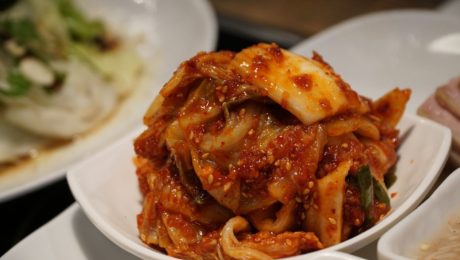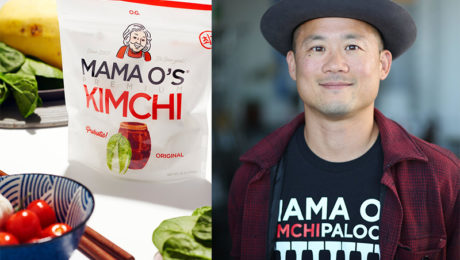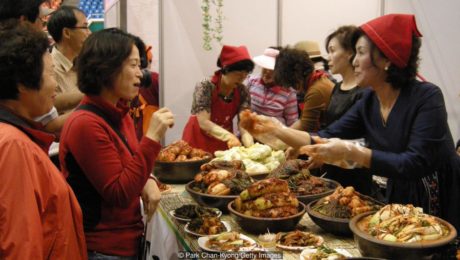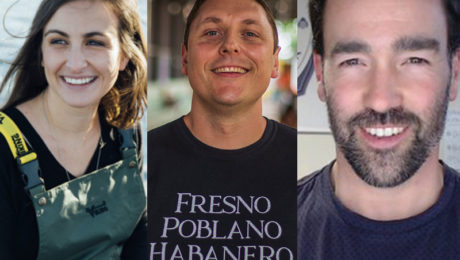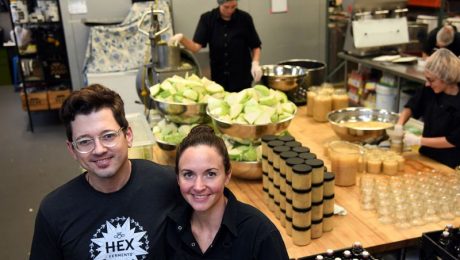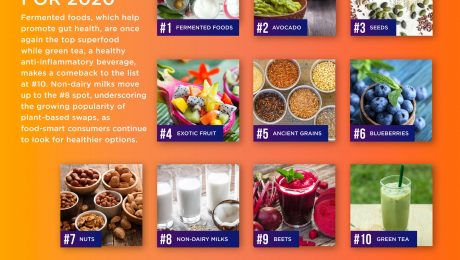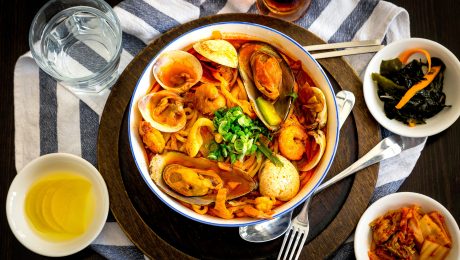What Gives Kimchi its Bacteria Superpower?
A fascinating study by the World Institute of Kimchi (WiKim) found that the cabbage in kimchi is a key source of lactobacilli in the fermented product. Garlic also contributes to the lactobacilli, while ginger and red pepper did not contribute. Of note, neither cabbage or garlic alone could replicate the final community of fermented kimchi. All vegetables were needed to bring the full bacterial community. The findings were published in the journal Food Chemistry. Researchers say it’s a building block to further understand food.
Peter Belenky, a professor of molecular microbiology and immunology who analyzed the study, said: “I think really what it tells us is that, yes, some ingredients bring specific bacteria, but you really need everybody working together in order to bring the full community.”
Read more (Popular Science)
- Published in Science
Q&A with Founder of Mama O’s Premium Kimchi
Kheedim Oh never aspired to start a food brand. The self-described “accidental entrepreneur” began Mama O’s Premium Kimchi in Brooklyn in 2007, in the midst of the Great Recession. With just $50 to his name, he started hauling giant jars of homemade kimchi to retailers on his skateboard.
Thirteen years later, Oh has grown the brand into one of the top fermented kimchi sold in the United States. Handcrafted kimchi is a labor-intensive food craft, but Oh doesn’t cut corners. He has never received a dime of funding and employs only a small team that uses his mother’s kimchi recipe.
“Everything we do is the time-honored, traditional way. From the experience of having to do it myself for so long, I’ve learned how to be as ruthlessly efficient in doing the steps to make the kimchi,” Oh says. “It takes time. But, to be honest, I don’t know how to do it another way. My goal is to make the best product.”
His kimchi, kimchi paste and kimchi kit have been praised by Food & Wine magazine and Williams Sonoma. Oh spent decades prior to Mama O’s building a name for himself in the entertainment industry as a DJ. It’s only been in the last few months that he stopped working regular DJ gigs “and that’s only because I’ve had to dedicate so much more energy into making the kimchi.” Oh still incorporates music into his work, creating novel stop-motion recipe videos incorporating Mama O’s kimchi. He also hosts Kimchipalooza, an annual festival in Brooklyn with live music and kimchi-centric tastings, demos and DIY workshops.
“I never had a 40 hour week job in my life. All I’ve done is hustle for gigs. I’m a hustler,” Oh says, adding: “I don’t mind it.”
Oh bounced from locations while growing his brand. From his apartment kitchen to a commercial kitchen space to a basement kitchen in a friend’s restaurant to a kitchen of a deli in Queens and, finally, to his current space in the Pfizer Building in Brooklyn.
“I’m not trying to grow this company and then sell it. That’s not my motivation. I’m blessed to be able to do something I enjoy, that’s positive, that’s good for people, that helps people. Ultimately, that’s what I’m doing: helping people.”
Below, a Q&A with the dynamic founder.
The Fermentation Association: Why did you start making kimchi?Kheedim Oh: I never set out to start a kimchi company. I needed kimchi for myself and all the kimchi in the stores were not to my liking. I asked my mom to teach me how to make it. I live in New York, my parents live in Maryland. It’s just too far to go bum a jar to kimchi so i asked my mom to teach me how to make it. I would take the Chinatown bus down to Maryland to make it. I would make a batch, but when you make a batch of kimchi at home, you typically do a 50-pound box of vegetables at a time. I would make it, bring it back in a cooler, then I’d wheel it back to my house on a skateboard because I couldn’t afford a taxi.
TFA: When did you move from making it as a hobby to selling it?
Oh: So I was making the kimchi and, at the time, I lived by myself. Fifty pounds is just way too much for your personal stash. I would give it away to my friends and they were like “This is so good, you should sell it.” I didn’t put much too much stake into that. But I was buying ribs from my butcher (Jeffrey’s Meat Market) and he was like “If you have kimchi and rice, you eat like a king.” So I gave him a batch, checked up on him a week later, and he said “I love it!” I said “You know I sell this shit?” and he said “I want to start carrying it.” At that point I had to come up with a name, incorporate, get insurance, all that stuff. I was making it out of the kitchen in my apartment, bringing it to him, he was only a couple blocks away. He was a total angel. He didn’t want any money, he just wanted to give me the opportunity to promote my business.
TFA: Tell me about the brand name, Mama O.
Oh: It was an homage to my mom because she taught me how to make it and what’s better than moms? You eat with your eyes before you eat with your mouth. So we call it Mama O’s Premium Kimchi, not Mama O’s Cutrate Kimchi. We strive to make the best tasting, highest rated, best kimchi. That went into it with our branding, how we wanted to portray ourselves. We may not be the biggest kimchi brand, but we’re definitely making the best.
TFA: Kimchi has traditionally been a recipe passed down through generations of Koreans. Today, that’s not happening as much. Do you think handcrafted kimchi is a dying food craft?
Oh: Yeah. It’s really sad. That was part of the reasoning why I wanted to learn to make it, because my mom makes really good kimchi. All of the stuff in the stores was just terrible. It was a link to my heritage that I really didn’t want to lose. I wanted to know how to make it just so I could have it. I invented Mama O’s Premium Kimchi Paste, which is the first paste for making kimchi at home. It’s my mom’s recipe. What’s great about the paste is it takes all the guesswork and grunt work out of it. What normally takes 3 hours takes 10 minutes because all the measuring and chopping is done.
TFA: You also created a homemade kimchi kit. Why sell a DIY kit?
Oh: It sells well around the holidays, especially. It’s a 7-inch cube, it’s a perfect gift size and it’s super cute. It’s the first kit of its kind. That kit took me two years to develop. I had to create the paste, then create the kit for it.
What’s great about the kit is it works every time — it takes the guesswork out of making kimchi. I have so many people tell me they tried to make kimchi on their own and it didn’t work. Kimchi tastes totally different when you’re making it to when it’s done fermenting it and eating it. With lactic acid fermentation, it’s transforming the food on the molecular level. So people, when they’re making it, they try to mess with the flavor to make it taste how they want, but the flavor changes through fermentation.
I’m trying to educate consumers and retailers on how they can use this paste with their vegetables. Retailers can take any vegetable past their prime and make kimchi with it, add value to things they potentially have to throw away. It’s the art of how to transform your vegetables. It’s a great way to maintain food sovereignty. You’re in control of what you make and what you put in your body.
TFA: How have Americans’ perception of kimchi changed from when you started to now?
Oh: It’s interesting because, definitely, there’s a greater awareness of it. It’s kind of confusing on two ends because people don’t know what good kimchi is. There are a lot of chefs that put kimchi on their menus, but it’s not really kimchi. It’s quick kimchi, they acidify it with vinegar.
I’m curious how exactly it will end up in the American diet because kimchi is part of the American food zeitgeist. Kombucha is fully incorporated — it’s an American thing now. But kimchi, I don’t know. I’m curious how people are going to want to eat their kimchi. I think it will possibly be in the form of salad or salad accompaniment. I think a lot of people like kimchi with their eggs in the morning. My favorite way, personally, is on a hot dog, with Western food. I fulfilled a lifelong dream – -one of my neighbors in Brooklyn is Joe’s Pizza. He made a kimchi pizza. I like it better than pepperoni. Kimchi and cheese is like Starsky and Hutch, it’s a great combination.
TFA: Where do you see the future of the industry for fermented products?
Oh: I see more of it, especially after whenever this outbreak settles. Though I got to say, what’s been interesting, the media and journalists have not been touting naturally fermented foods which they should be. I get the resistance to promoting probiotic supplements, I don’t think they’re good either. But I don’t get why no one is promoting fermented foods naturally to people because this has been saving people’s health since the beginning of time.
I see the fermented space growing. I’m curious to see if the supplement industry is going to blow up. I’m not a proponent of the probiotic supplement industry.
TFA: What’s your advice for other startups wanting to start a fermentation brand?
Oh: (Laughs) Besides don’t. Food is tough. Especially now because I think it’s going to get even harder. Really, I wouldn’t want to discourage anyone. But coming out of this, so many people are going to want to start a food brand. You’ll have people coming in that have funding.
That said, you have to love food to do it. But only do it if you love it. But if you don’t love it and you just want to make a killing at it, that’s not going to work. As they say, it takes 10 years to be an overnight success in the food business.
TFA: What are the future plans for Mama O’s Premium Kimchi?
Oh: Right now, I want to start more partnerships with restaurants when they open again. A lot of restaurants don’t have the time to make it, but I don’t want them making quick kimchi and passing it off as real kimchi.
We are launching our first hot sauce — Kimchilli — in May with Whole Foods. I’m super excited to launch the hot sauce.
I’m super lucky — I wish people would acknowledge luck in their success. I was fortunate with my timing, the new science with the mind-gut connection was starting to come out. I’m really trying to make things that people need. And do a lot of education.
Ultimately my goal is to change how Americans eat and encourage them to eat more like Korean people. I totally get the appeal of a Western diet. I love a good steak. But you can’t just eat a steak. You have to have sides and all of that with it. Just a steak is obscene. I’m really trying to encourage people to eat in a way where meat isn’t the main thing, it’s just an accompaniment. Eat more traditionally fermented foods. One interesting thing with fermented foods is it’s not all the same probiotics. Kombucha affects me differently than when I eat kimchi. Even yogurt, I feel it does the least for me. But it’s based on your personal chemistry as well. It all depends on what works for you, then incorporating things in your diet. There’s a lot of education that needs to happen.
- Published in Business, Food & Flavor
South Korea’s Kimchi Capital
BBC Travel “Comeback Cities” series explores Gwangju, South Korea’s 6th largest city that is considered the birthplace of kimchi. Kimchi sauces are different by store in Gwangju, differing between seasoning levels and even experience of the kimchi maker. Hooni Kim runs the New York restaurant Danji , which became the world’s first Michelin-starred Korean restaurant in 2012. He shares “the secret ingredient to Gwangu’s culinary depth:” a regional version of jeotgal, which is a fermented seafood. Kim calls it “natural MSG,” a sauce made of “shrimp, squid, oyster, any kind of fish.” Jeotgal is a key ingredient in kimchi.
Read more (BBC Travel)
- Published in Business
Bubbling Over: Is Fermentation More Than a Fad
We asked three fermentation experts if recent popularity of fermented foods is a fading trend or a new food movement. These industry professionals weigh in on their predictions for fermentation’s future. The fermenters include: Bri Warner (CEO of Atlantic Sea Farms, a commercially viable seaweed farm that makes kelp kraut and kimchi), Nicholas Gregory (owner of Pulp Hot Sauce, an Atlanta-based fermented condiment brand), Joshua Rood (co-founder and CEO Dr Hops Kombucha beer, a health-conscious alcohol).
Do you think the surge of fermented food and drinks is a trend will disappear or a new food movement here to stay?
Bri Warner, CEO Atlantic Sea Farms: “Now that we have a robust understanding of how good gut health effects overall health, I think fermentation is here to stay. I do think the category will continue to innovate to remain relevant, with a stronger focus on quality ingredients that are good for people, planet, and, in our case, oceans!”
Nicholas Gregory, owner Pulp Hot Sauce: “I think the current fermented food movement is here to stay. We are at an intersection of technology, science and health further than we have ever seen in human history. The internet, television, several seminal books and air travel have given us unprecedented exposure and access to information. This exposure and access to food and world cultures is more in depth than ever before. Including the food history and traditions of those cultures. Combine that awareness with a relatively intelligent and sophisticated medical system; an understanding of healthy lifestyles, a willingness to make healthy decisions, an understanding of the benefits of a healthy gut biome and how it all correlates to a longer, happier, healthier life. Along with a craving for umami and fermented funky flavors for a growing number of the population. I believe we are in the middle of a movement that shows no signs of slowing down or going away anytime soon. In fact, I see it only becoming more popular, more normal, more accepted, more diverse, more creative and more exciting in the decades to come.”
Joshua Rood, co-founder and CEO Dr Hops Kombucha beer: “As co-founder and CEO of Dr Hops Kombucha Beer, I appreciate that there is currently a powerful trend towards living, fermented foods. But answering the question of whether or not that will continue is repugnant. We here at Dr Hops are driving that trend! We are not playing the game of hoping that it will simply continue. We are committing ourselves, each day, to the life-enhancing awesomeness of fresh, authentic, fermented foods and beverages. Please join us in that! Join us in leading the health-conscious food and beverage revolution!”
- Published in Business
Sauerkraut Growing Thanksgiving Tradition
Americans with German and Eastern European descent make sauerkraut part of their Thanksgiving tradition. The Baltimore Sun highlights Baltimore-based Hex Ferments that produces a few tons of sauerkraut a month, in multiple varieties. Sales are going so well (Hex Ferments makes kombucha and kimchi, too) that they’ll be expanding to a bigger production facility in 2020. Hex Ferments cofounder Meaghan Carpenter said: “I think sauerkraut can save the world.”
Read more (The Baltimore Sun)
- Published in Food & Flavor
Fermented Seaweed Products Use 2020’s Super Ingredient
Seaweed will be 2020’s super ingredient, according to Bloomberg. The regenerative ocean plant is being used by entrepreneurs in fermented food products like hot sauce, tea, alcoholic beverages and even kimchi and sauerkraut. Atlantic Sea Farms in Maine is the largest kelp aquaculture business in the U.S. and makes Sea-Chi (spicy marine version of kimchi) and Sea-Beet Kraut (beets, carrots and kelp). Atlantic Sea Farms, run by former diplomat Briana Warner, plants to expand its harvest and production from 250,000 pounds this year to 600,000 pounds in 2020.
Read more (Bloomberg)
- Published in Food & Flavor
Fermented Foods Again Top Superfoods List
For the third year in a row, fermented foods tops Today’s Dietitian list of the year’s No. 1 superfood. The annual “What’s Trending in Nutrition” survey reveals the hottest food and nutrition trends to look for in 2020.
“The 2020 survey results send a clear and consistent message. Consumers want to live healthier lives,” says Louise Pollock, president of Pollock Communications. “They have access to an incredible amount of health information, and they view food as a way to meet their health and wellness goals. Consumers are taking control of their health in ways they never did before, forcing the food industry to evolve and food companies to innovate in response to consumer demand.”
Consumers are using fermented products as “powerhouse foods,” foods that boost gut health and reduce inflammation. Some nutrition experts recommend fermented foods should be included in national dietary recommendations.
In April, Today’s Dietitian published an article “The Facts About Fermented Foods.” In it, Dr. Robert Hutkins, a researcher and professor of food science at the University of Nebraska-Lincoln, shared his expert opinion on fermentation. Hutkins wrote what many in the field consider the most exhaustive textbook on fermentation, “Microbiology and Technology of Fermented Foods.” He explained how fermented foods have a long history in the human diet.
“Indeed, during much of human civilization, a major part of the human diet probably consisted of bread, yogurt, olives, sausages, wine, and other fermentation-derived foods,” Hutkins told Today’s Dietitian. “They can be considered perhaps as our first ‘processed foods.’”
Hutkins, who studies the bacteria in fermented foods, said researchers like himself “are a bit surprised fermented foods suddenly have become trendy.”
“Consumers are now more interested than ever in fermented foods, from ale to yogurt, and all the kimchi and miso in between,” he says. “This interest is presumably driven by all the small/local/craft/artisan manufacturing of fermented foods and beverages, but the health properties these foods are thought to deliver are also a major driving force.”Fermented foods first appeared in the survey of registered dietitian nutritionists (RDNs) in 2017, where it was the 4th most popular superfood.
The full superfoods list includes:
- Fermented foods, like yogurt and kefir
- Avocado
- Seeds
- Exotic fruit, like acai, golden berries
- Ancient grains
- Blueberries
- Nuts
- Non-dairy milk
- Beets
- Green tea
- Published in Food & Flavor, Health
NYT: Does Kombucha Health Claims Live Up to Hype?
The New York Times asks: are there benefits to drinking kombucha? The article explores hard kombucha and the health claims of drinking the fermented tea. “But for those interested in integrating a variety of microbes into their diet, Dr. Emeran Mayer, author of ‘The Mind-Gut Connection,’ recommends doing so naturally. ‘I personally drink it occasionally,’ he said. Instead of using pills or supplements, he said, alternate different fermented foods, including sauerkraut, kimchi, cultured milk products, and, yes, kombucha.
Read more (New York Times)
- Published in Food & Flavor, Health
North Koreans Buying Premade Kimchi Versus Making Their Own
Fewer North Koreans are making their own kimchi, opting for premade versions instead. The final days of October have traditionally marked kimchi-making season in North Korea. The kimchi-making craft was always a crucial part of prepping for winter months. The Daily NK notes that there’s no longer a need for homemade kimchi as more women join the workforce, more commercial kimchi producers enter the market and more convenient, processed food is sold in North Korean supermarkets. The final days of October have traditionally always marked kimchi-making season in North Korea. The traditionally kimchi-making craft was always a crucial part of prepping for winter months.
Read more (Daily NK)
- Published in Food & Flavor
Cabbage Elevated: Fermented Cabbage Dishes Star of Today’s Cuisine
The Washington Post writes: “From common to cool: The lowly cabbage has become a star.” Paul Kaham, an award-winning chef in Chicago, said “It’s all about how it is prepared, how it is elevated.” The article details how fermented cabbage dishes are a staple to many countries cuisine, like kimchi in Korea and sauerkraut in Poland, Germany and Eastern Europe. Produce stores note consumer’s increasing demand for cabbage, too, specifically the Napa cabbage variety which is often used for fermentation and pickling. Once a staple in Asian groceries and restaurants, Napa cabbage is gaining popularity in non-Asian grocery stores as well.
Read more (The Washington Post)
- Published in Business

